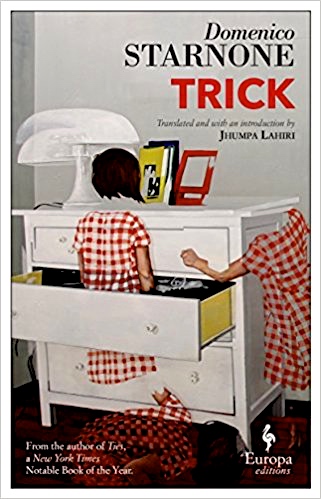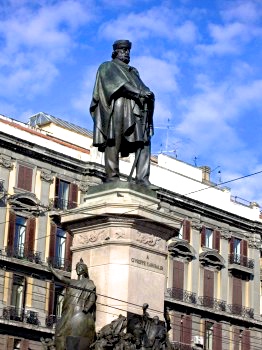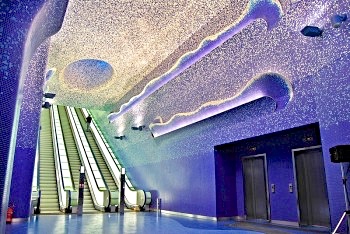“It was a journey plagued by cold sweats and the desire to head back to Milan. It was raining and I felt tense. The train sliced through gusts of wind that cloud the window with trembling rivulets of precipitation. I was often scared that the [train cars], felled by the storm, would jump the tracks, and I realized the more one aged, the more it mattered to stay alive.”—thoughts of main character Daniele Mallarico, elderly illustrator of literary fiction.
 Daniele Mallarico, in his seventies, is on his way from Milan to Naples, where he has agreed to care for his four-year-old grandson Mario for three days so that his daughter and son-in-law can attend a professional mathematics conference. Daniele, already late with illustrations he has agreed to create for a new edition of Henry James’s “The Jolly Corner,” has been ill, and he and his daughter have not been close, even during and after his recent surgery. He has not seen his only grandchild for two years. The house where he will be staying, however, is the one in which he grew up – and where he has left ghosts – part of an elegant, centuries-old building overlooking the busy Piazza Garibaldi in Naples. Mallarico’s arrival in Naples begins author Domenico Starnone’s novel and is quite different from what one would expect from the above summary, the many blurbs on-line and on the book’s back cover, and the novel’s obviously “cute” cover illustration. For unknown reasons, the chosen cover shows ghostly images of a curious school-age girl exploring a modern, painted bureau, neither of which plays any role at all in this thoughtful literary novel.
Daniele Mallarico, in his seventies, is on his way from Milan to Naples, where he has agreed to care for his four-year-old grandson Mario for three days so that his daughter and son-in-law can attend a professional mathematics conference. Daniele, already late with illustrations he has agreed to create for a new edition of Henry James’s “The Jolly Corner,” has been ill, and he and his daughter have not been close, even during and after his recent surgery. He has not seen his only grandchild for two years. The house where he will be staying, however, is the one in which he grew up – and where he has left ghosts – part of an elegant, centuries-old building overlooking the busy Piazza Garibaldi in Naples. Mallarico’s arrival in Naples begins author Domenico Starnone’s novel and is quite different from what one would expect from the above summary, the many blurbs on-line and on the book’s back cover, and the novel’s obviously “cute” cover illustration. For unknown reasons, the chosen cover shows ghostly images of a curious school-age girl exploring a modern, painted bureau, neither of which plays any role at all in this thoughtful literary novel.
This novel is serious, not cute, despite its innate charm. Here the author uses irony and dark humor for his primary dramatic effects, contrasting the age and thinking of the elderly grandfather and his precocious grandson as he raises questions about how we become who we are, and what, if anything, we can do about it. His narrative style keeps the reader involved, non-stop, captivated by the novel’s ideas and its many surprises, a real treat for grownups who admire well-developed literary fiction with philosophical and psychological overtones and serious themes presented with panache and style. Mallarico arrives in Naples exhausted and out of sorts, unsure of himself because of his long physical recovery after surgery and his difficulties in getting inspired enough to create the plates he needs to illustrate Henry James’s story, “The Jolly Corner.” Though author Starnone does not spend a lot of time drawing obvious parallels and contrasts between his own novel and James’s short story – and does not make the reader feel that s/he needs to read the James short story in order to like and understand Trick – some parallels are clear: In both narratives, an older person returns home after being away for many years to find himself questioning how he became the person he is, exploring new ideas about what he might have become, and questioning his choice of profession, in particular. His interests and possibly his abilities now seem very different from what he has pursued in the past. This leads him to wonder whether he has wasted his life following a wrong path as he confronts his personal ghost, his alterego.
In Trick, Mallarico is aided, unwittingly, by Mario, his four-year-old grandson, who is also facing significant issues as he begins making new choices offered by his grandfather and recognizes these choices and their outcomes as different from the choices offered by his mother and father. His grandfather offers him much more freedom, leading Mario to see alternatives, as Mallarico recognizes that all children have unique potential which must be recognized and encouraged if the child is to feel fulfilled. Mario, precocious and intelligent, knows how to turn on the gas stove, how to set the table, and all manner of household dos and don’ts, and when he decides that he does not want to go to nursery school and to stay with his grandfather for the day instead, Mallarico agrees. He allows Mario to be messy, to take chances, and to explore and experiment. In the meantime, he is aware that he himself no longer wants to work on illustrations for the Henry James story. He recognizes that a person making big commitments to one profession or one person or one talent, at the expense of others, limits his/her potential, and knowing when or where to draw the line, over time, makes the difference between long-term happiness and dissatisfaction. He realizes that he has felt this way for ten or fifteen years, recognizes that he is in decline, and believes that his imagination is worn out.

Behind the Garibaldi statue is an apartment house like the one that belonged to the family of Daniele Mallarico. The unit in the top right, with the balcony, is like the one described here.
Watching Mario gives him some new ideas, however, and when Sally, the maid/cook, gets locked out of the house, it is Mario who figures out how to get her back inside. Mallarico and Mario continue to lock horns, however, as Mallarico faces ghosts from the past, along with the memories inspired by looking through an old family album and a collection of his own early drawings. Eventually, he takes a new approach to his contract of illustrating Henry James, creating images inspired by his own family apartment, his own adolescent years, and his own ghosts. Eventually, Mario wants to draw what he sees his grandfather drawing so that they can “work together,” an event which leads to some new understanding, at the same time that it creates a major crisis between them. Eventually, Mallarico finds himself helpless in dealing with a terrible problem that only young Mario can solve. In turn, Mario ends up in a predicament which needs Mallarico’s help though he cannot give it until Mario helps him first. From opposite ends of life – Daniele Mallerico, near death, and Mario just recently coming alive – they begin to affect each other, Mallarico filled with thoughts of the past and Mario filled with thoughts of the future, leading Mallarico finally to conclude, “I don’t know if I’m scared for the child or scared of the child.”

Mario persuades Mallarico to take him to the subway, where he wants to ride the escalators. With escalators like these, it’s easy to see why. Photo by Oscar Tusquet Blanca
Sensitively translated with all the subtleties of complex Neapolitan expressions explored until she is satisfied with the result in English, author/translator Jhumpa Lahiri adds her own formidable skills to this remarkable and thought-provoking novel. “My hope,” she says, “was to channel Starnone’s style, to write as if he were writing, to somehow copy and paste him into English. This…involves something of a trick….Starnone’s text remains the parent that spawned this translation, but somewhere along the road to its English incarnation, it also became a ghost.” The book is thoughtful and rewarding – brilliant – and is high on my Favorites list for the year.
Photos. The author’s photo appears on http://images.gqitalia.it
Piazza Garabaldi, by Ansalmo Breda, is from https://www.flickr.com/
The Garibaldi statue, with a centuries-old apartment building behind it, shows a 6th floor apartment (top right) with balcony like the one described as belonging to Mallarico’s family. https://upload.wikimedia.org
The metro station, restored and rebuilt by Oscar Tusquets Blanca, is from https://www.pinterest.com
Another Metro photo of the supports for the underground development appears on https://www.pinterest.com



